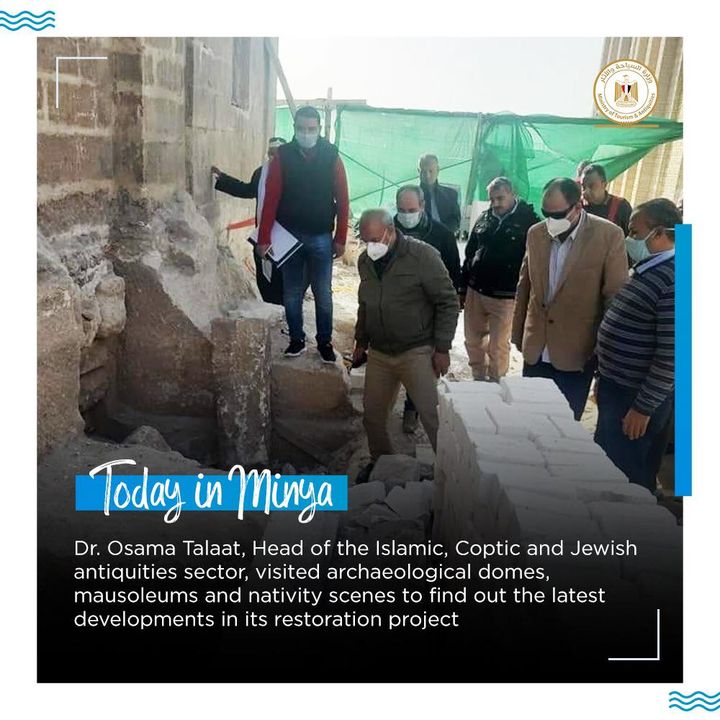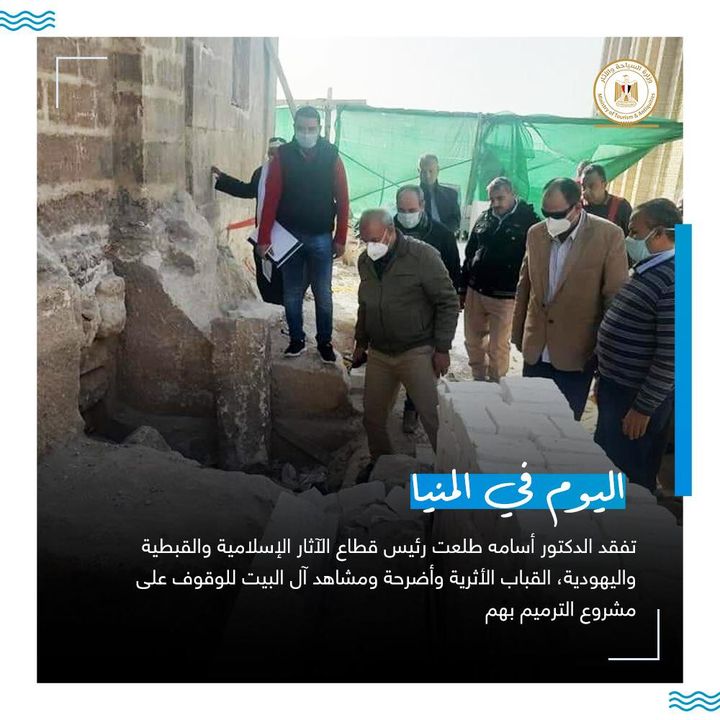في اطار جهود وزارة السياحة والآثار لتطوير وتحسين الخدمات السياحية بالمتاحف والمواقع الأثرية، والجهود المبذولة ضمن مشروع ترميم آثار قرية البهنسا بمحافظة المنيا، تفقد الدكتور أسامه طلعت رئيس قطاع الآثار الإسلامية والقبطية واليهودية، القباب الأثرية وأضرحة ومشاهد آل البيت بالقرية للوقوف على مستجدات سير أعمال مشروع الترميم بها.
وأوضح د. أسامه طلعت أن مشروع ترميم آثار البهنسا يتم بالتعاون مع جهاز مشروعات الخدمة الوطنية للقوات المسلحة تحت إشراف المجلس الأعلى للآثار، ويهدف المشروع إلى إعادة تاهيل الموقع الأثري وتطوير المنطقة المحيطة به لرفع كفاءة الخدمات السياحية وعمل شبكة من الطرق، تمهيدًا لوضعها على الخريطة السياحية.
وأضاف أن المشروع يتضمن ترميم الأضرحة الموجودة وتطوير مداخل ومخارج المنطقة وعمل شبكة إضاءة كاملة لها ووضع لوحات إرشادية للتعريف بالأضرحة وأصحابها، بإلاضافة إلى إحاطتها بأسوار لحمايتها يكون بها أبواب خشبية ذات طراز إسلامي يتناسب مع الطبيعة الأثرية للمكان وتركيب بلاط حجري واستبدال الأسقف التالفه.
كما تفقد رئيس قطاع الآثار الإسلامية والقبطية واليهودية، الأعمال الجارية بمشروع ترميم الكنيسة الأثرية وأعمال التطوير الواقعة في نطاق دير السيدة العذراء بجبل الطير بمركز سمالوط محافظة المنيا من تمهيد الطريق المؤدي للكنيسة، بطول ٥٠٠ متر، كما يتم وضع لوحات إرشادية وعمل مركز للزوار وسور يحيط بالكنيسة، بالإضافة إلى تطوير واجهات المقابر على جانبي الطريق المؤدي للكنيسة .
وتعد هذه الكنيسة من أهم النقاط على مسار رحلة العائلة المقدسة في مصر، حيث يوجد بداخلها المغارة التى لجأت إليها العائلة المقدسة أثناء وجودها في المنيا على مدار العام.
ويذكر أن قرية البهنسا تقع على بعد 16 كيلو مترا من مركز بني مزار، بمحافظة المنيا وتعد من أهم القرى الأثرية في مصر، حيث يوجد بها آثار من مختلف العصور التاريخية.
وفي الفترة الرومانية؛ عرفت البهنسا كمدينة قديمة اسمها بيمازيت، أما في العصر الإسلامي فتحها قيس بن الحارث المرادي سنة 22 هجرية وسميت ولاية البهنسا لتمتد من منطقة الواسطي حتى سمالوط، واستمرت كعاصمة الإقليم حتى منتصف القرن الثامن عشر الميلادي.
ويزيد من قيمتها التاريخية شمولها على عدد كبير من مشاهد ومقابر صحابة النبي- صلى الله عليه وسلم- ونظرا لذلك عرفت باسم أرض الشهداء أو البقيع الثاني لكثرة المسلمين الذين اسشهدوا بها أثناء الفتح الإسلامي للبهنسا.
ومن أشهر المزارات والمعالم التاريخية بقرية البهنسا 17 قبة ضريحية للصحابة والتابعين الصالحين كقبة السبع بنات، ومقام سيدي جعفر وعلى أولاد عقيل بن علي بن أبى طالب، وقبـة التكرورى، ومقـام سيدي الأمير زياد بن الحرث بن أبي سفيان بن عبد المطلب، ومقام ابان بن عثمان بن عفان، وقبـة محمد بن ابى عبد الرحمن بن ابى بكر الصديق، وأيضا مسجد الحسن الصالح بن زين العابدين بن الحسين بن على بن ابى طالب.
To follow up on the progress of the project of restoring the archeological village of Al-Bahnasa in Minya, Dr. Osama Talaat, head of the Islamic, Coptic and Jewish antiquities sector, visited the archaeological domes, mausoleums and nativity scenes in the village.
Dr. Osama Talaat said that this project is carried out in cooperation with the National Service Projects Organization of the Armed Forces under the supervision of the Supreme Council of Antiquities. He added that the project aims to rehabilitate the archaeological site and develop the surrounding area to raise the efficiency of tourism services and create a network of improved roads, in preparation for placing it on the tourism map of Egypt.
He said that the project includes restoring the shrines, developing the entrances and exits of the area, building a complete lighting system, and putting in place labels to identify the shrines and their owners, in addition to surrounding them with fences to protect them with Islamic-style wooden doors that fit the archaeological nature of the place, installing stone tiles and replacing the damaged ceilings.
The head of the Islamic, Coptic and Jewish Antiquities Sector also followed up on the progress of work in the project of restoration of the ancient church and the work within the Monastery of the Virgin in Jabal al-Tair in Samalut, Minya. This included paving 500 meters of the road leading to the church, in addition to placing labels and building a visitor center and a wall surrounding the church. In addition to the development of tomb façades on both sides of the road leading to the church.
This church is one of the most important places on the path of the Holy Family’s journey in Egypt, as there is a cave inside where the Holy Family sought refuge while in Minya throughout the year.
It is noteworthy that the village of Al-Bahnasa is located 16 kms from the center of Bani Mazar, in Minya, and it is considered one of the most important archaeological villages in Egypt, as there are monuments from various historical eras.
During the Roman period; Al-Bahnasa was known as an ancient city called Bimazit, but in the Islamic era, Qais bin Al-Harith Al-Mouradi conquered it in the year 22 AH.
Its historical value increases for its inclusion of a large number of scenes and tombs of the companions of the Prophet – PBUH – and in view of that it was known as the Land of the Martyrs because of the large number of Muslims who lived in it during the Islamic conquest of Bahnasa.
Among the most famous historical sights and landmarks in the village of Al-Bahnasa are 17 shrine domes for the righteous companions and followers, such as the Dome of the Seven Girls, the shrine of Sidi Gafaar and the children of Aqil bin Ali bin Abi Talib, the dome of Al-Takruri, the tomb of Prince Ziyad bin Abi Sufyan bin Abdul Muttalib, and the shrine of Aban bin Othman bin Affan, the dome of Muhammad bin Abi Abd al-Rahman bin Abi Bakr al-Siddiq, and also the Hassan al-Salih bin Zain al-Abidin bin al-Hussein bin Ali bin Abi Talib mosque.

